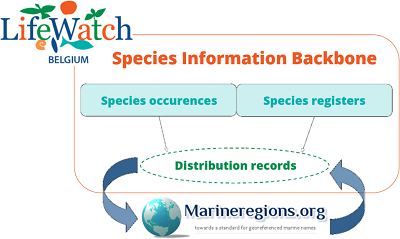LifeWatch
Background
|
LifeWatch was established as part of the European Strategy Forum on Research Infrastructure (ESFRI) and can be seen as a virtual laboratory for biodiversity research. The concept behind LifeWatch was developed in the 1990s and early 2000s, with the support of EU Networks of Excellence related to biodiversity and ecosystem functioning. This - amongst others - included the MarBEF project, which funded the creation of the Marine Gazetteer. |

|
Belgium contributes to LifeWatch with varied and complementary "in-kind" contributions. These are implemented under the form of long lasting projects by different research centers and universities spread over the country and supported by each respective political authority. Within LifeWatch, the Flanders Marine Institute - host of the World Register of Marine Species (WoRMS) - has taken on the responsibility to develop the LifeWatch Species Information Backbone (LW-SIBb).
LifeWatch mission
The mission of LifeWatch is to advance biodiversity research and to answer long-standing ecological questions by providing data and - more importantly - easy access to data.
The LifeWatch mission is being achieved by giving access to data and information through a single infrastructure which (virtually) brings together a large range and variety of datasets, services and tools. Scientists can use these tools and services to construct so-called Virtual Research Environments (VREs), where they are able to address specific questions related to biodiversity research, including e.g. topics related to preservation.
The construction and operation of the LifeWatch e-infrastructure is revolutionizing the way scientists can do biodiversity research. They are not only offered an environment with unlimited computer and data storing capacity, but there is also transparency at all stages of their research process and the generic application of the e-infrastructure open the door towards more inter- and multidisciplinary research.
Marine Regions & LifeWatch
|
The Marine Regions Gazetteer is a standard list of marine georeferenced place names and areas. Beside this list, shapefiles of Maritime Boundaries are created and/or shared. The Marine Regions Gazetteer provides the link between the species registers and the species occurrence databases in the LifeWatch Species Information Backbone. Different web services of Marine Regions are part of the e-lab of Lifewatch.
|

|

